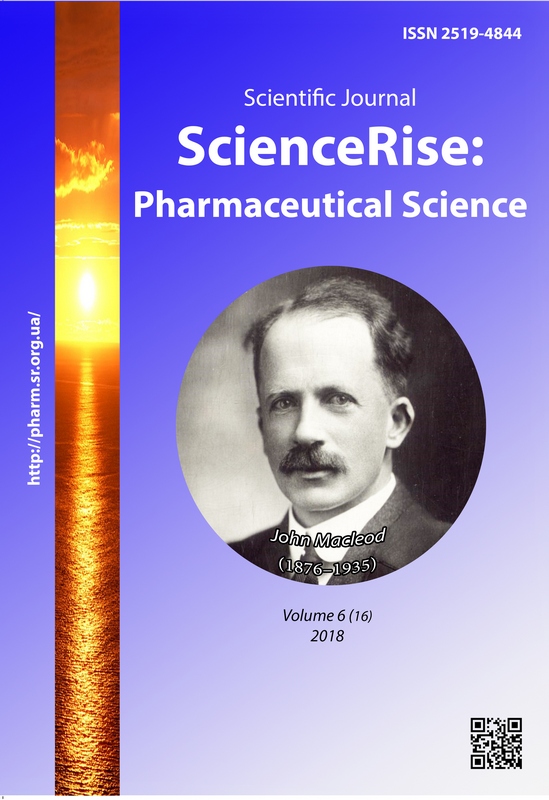Search of the promising species of subfamily Amygdaloideae and Pyroideae using the chemotaxonomy
DOI:
https://doi.org/10.15587/2519-4852.2018.153199Keywords:
Rosaceae, hawthorn, apple, cherry, plum, leaves, flowers, fruits, taxon, chemotaxonomyAbstract
World flora has more than 1000 species of the genus Сrataegus L., more than 30 species belong to the subgenus Prunus L., genus Malus Mill. has 100 species, subgenus Cerasus Juss. includes more than 150 species. Despite the diversity of species and a sufficient resource base, only a few representatives of the genus sufficiently researched and found their use as sources of biologically active substances (BAS).
Aim of research. To conduct a chemotaxonomic study of representatives of the genus Сrataegus L., Prunus L., Malus Mill., Cerasus Juss.; to establish a promising sources of biologically active substances for the drugs production.
Materials and methods. Chemotaxonomic study was carried out using the method of the graph analysis. The chemomarkers were phenolic compounds and terpenoids, identified in the generative and vegetative organs of the representatives of the genus Сrataegus L., Prunus L., Malus Mill., Cerasus Juss. The terpenoids and organic acids were identified by a chromatography-mass-spectrometric method on an Agilent Technology 6890N chromatograph with a 5973N mass-spectrometric detector. Flavonoids and hydroxycinnamic acids were detected by chromatography.
Results. The chemical profiles of vegetative and generative organs of 34 species of the genus Сrataegus L. are established, 5 species of the genus Prunus L., 7 species of the genus Malus Mill., 4 species of the genus Cerasus Juss. The promising species of hawthorn, wich accumulated a general group BAS of genus was detected.
Conclusion. According to the results of a chemotaxonomic study of representatives of subgenus Amygdaloideae and Pyroideae was detected a promising sources of biologically active substances (BAS) among species of the genus Crataegus L., Prunus L., Malus Mill. and Cerasus Juss. The chemical profiles are forming flavonoids, terpenoids and aromatic acids. The promising species of hawthorn was added to the complex «Kratophyt»
References
- Phipps, J. B., Robertson, K. R., Rohrer, J. R., Smith, P. G. (1991). Origins and Evolution of Subfam. Maloideae (Rosaceae). Systematic Botany, 16 (2), 303–332. doi: http://doi.org/10.2307/2419283
- Talent, N., Dickinson, T. A. (2005). Polyploidy in Crataegus and Mespilus (Rosaceae, Maloideae): evolutionary inferences from flow cytometry of nuclear DNA amounts. Canadian Journal of Botany, 83 (10), 1268–1304. doi: http://doi.org/10.1139/b05-088
- Goncharov, N. F., Kovaleva, A. M., Komissarenko, A. N. (2008). Fenol'nye soedineniya severoamerikanskikh vidov roda boyaryshnik. Rossiyskiy mediko-biologicheskiy vestnik imeni akademika Pavlova, 3, 150–154.
- Kamelin, R. V. (2006). Rozotsvetnye (Rosaceae). Bornaul, 100.
- Potter, D., Eriksson, T., Evans, R. C., Oh, S., Smedmark, J. E. E., Morgan, D. R. et. al. (2007). Phylogeny and classification of Rosaceae. Plant Systematics and Evolution, 266 (1-2), 5–43. doi: http://doi.org/10.1007/s00606-007-0539-9
- Eremin, G. V. (2017). Genofond roda Prunus L. Trudy po prikladnoy botanike, genetike i selektsii, 164, 208–217.
- Sydora, N. (2018). Morphological and taxonomic study of oxyacanthae Zbl. section of crataegus L. genus by vegetative characteristics. ScienceRise: Pharmaceutical Science, 1 (11), 36–41. doi: http://doi.org/10.15587/2519-4852.2018.124432
- Chen, J., Song, S., He, J., Xu, S. (2008). A study of the chemical constituents of the leaves of Crataegus pinnatifida. Asian Journal of Traditional Medicines, 3, 80–83.
- Hamahameen, B. A., Jamal, B. (2013). Determination of Flavonoids in the Leaves of Hawthorn (Crataegus Azarolus) of Iraqi Kurdistan Region by HPLCAnalysis. International Journal of Bioscience, Biochemistry and Bioinformatics, 3 (1), 67–70. doi: http://doi.org/10.7763/ijbbb.2013.v3.166
- Lenchyk, L. V., Upyr, D. V., Ovezgeldiyev, D. (2016). Phytochemical investigation of bird cherry fruits. Der Pharmacia Lettre, 8 (6), 73–76.
- Sydora, N., Kоvalova, A., Komissarenko, A. (2016). Gas chromatographic-mass spectrometric studies of organic acids of Crataegus pedicelata Sarg leaves. Science and Education Studies, 2 (1 (17)), 769–774.
- Bicchi, C., Brunelli, C., Cordero, C., Rubiolo, P., Galli, M., Sironi, A. (2016). Methods of the chromate-mass-spectrometric research. Journal of Chromatography A, 1-2, 195–207.
- Kovaleva, A. M., Goncharov, N. F., Komissarenko, A. N., Sidora, N. V., Kovalev, S. V. (2009). GC/MS study of essential oil components from flowers of Crataegus jackii, C. robesoniana, and C. flabellata. Chemistry of Natural Compounds, 45 (4), 582–584. doi: http://doi.org/10.1007/s10600-009-9373-3
- Sydora, N. V., Kоvalova, A. M. (2016). Gas chromatographic-mass spectrometric studies the volatile compounds and organic acids the leaves of Crataegus macracantha Loud. American Journal of Science and Technologies, 3 (1 (21)), 1041–1045.
- Lenchyk, L., Shapoval, O., Kyslychenko, V. (2016). Phytochemical study and determination of pharmacological activities of cherry shoots dry extract. ScienceRise: Pharmaceutical Science, 1 (1), 40–45. doi: http://doi.org/10.15587/2519-4852.2016.72746
- Lenchyk, L. V. (2016). Determination of phenolic compounds in prunus domestica leaves extract. Scripta Scientifica Pharmaceutica, 2 (2), 31–35. doi: http://doi.org/10.14748/ssp.v2i2.1302
Downloads
Published
How to Cite
Issue
Section
License
Copyright (c) 2019 Natalia Sydora, Alla Kovaleva, Alexandr Goncharov

This work is licensed under a Creative Commons Attribution 4.0 International License.
Our journal abides by the Creative Commons CC BY copyright rights and permissions for open access journals.








